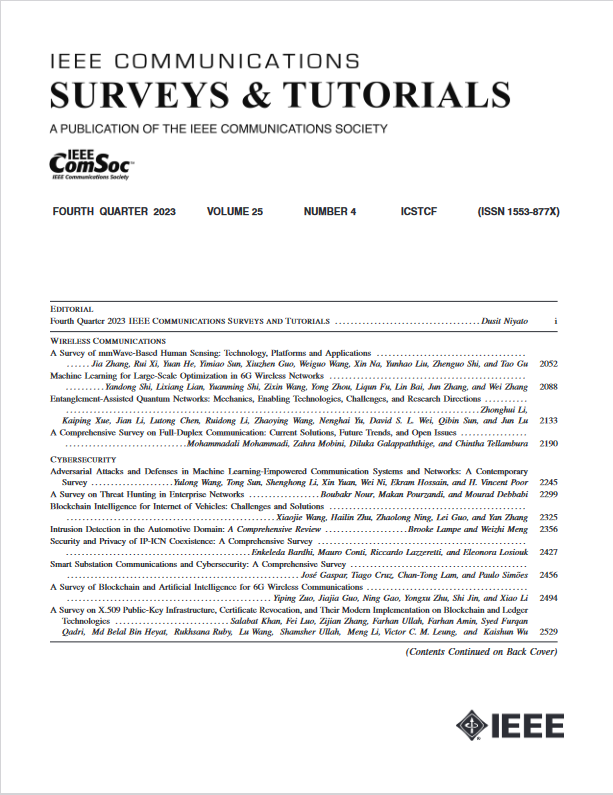基于模型、启发式和机器学习的无线网络优化方法概览
IF 34.4
1区 计算机科学
Q1 COMPUTER SCIENCE, INFORMATION SYSTEMS
引用次数: 0
摘要
可重构智能表面(RIS)作为设想中的 6G 网络的关键推动因素,以低能耗和低硬件成本提高网络容量、覆盖范围、效率和安全性为目的,受到了广泛关注。然而,将 RIS 集成到现有基础设施中会大大增加网络管理的复杂性,尤其是在控制大量 RIS 元件时。要充分发挥 RIS 的潜力,高效的优化方法至关重要。本研究全面考察了 RIS 辅助无线通信的优化技术,包括基于模型的算法、启发式算法和机器学习(ML)算法。特别是,我们首先总结了文献中具有不同目标和约束条件的问题表述,如总和最大化、功率最小化和不完善信道状态信息约束条件。然后,我们介绍了文献中使用过的基于模型的算法,如交替优化法、大化-最小化法和连续凸近似法。接下来,我们讨论了启发式优化法,它采用启发式规则来获得低复杂度的解决方案。此外,我们还介绍了针对 RIS 的最先进的 ML 算法和应用,即有监督和无监督学习、强化学习、联合学习、图学习、迁移学习和基于分层学习的方法。我们从稳定性、鲁棒性、最优性等方面对基于模型的方法、启发式方法和 ML 方法进行了比较,从而对这些技术有了系统的了解。最后,我们重点介绍了面向 6G 网络的 RIS 辅助应用,并指出了未来的挑战。本文章由计算机程序翻译,如有差异,请以英文原文为准。
A Survey on Model-Based, Heuristic, and Machine Learning Optimization Approaches in RIS-Aided Wireless Networks
Reconfigurable intelligent surfaces (RISs) have received considerable attention as a key enabler for envisioned 6G networks, for the purpose of improving the network capacity, coverage, efficiency, and security with low energy consumption and low hardware cost. However, integrating RISs into the existing infrastructure greatly increases the network management complexity, especially for controlling a significant number of RIS elements. To realize the full potential of RISs, efficient optimization approaches are of great importance. This work provides a comprehensive survey of optimization techniques for RIS-aided wireless communications, including model-based, heuristic, and machine learning (ML) algorithms. In particular, we first summarize the problem formulations in the literature with diverse objectives and constraints, e.g., sumrate maximization, power minimization, and imperfect channel state information constraints. Then, we introduce model-based algorithms that have been used in the literature, such as alternating optimization, the majorization-minimization method, and successive convex approximation. Next, heuristic optimization is discussed, which applies heuristic rules for obtaining lowcomplexity solutions. Moreover, we present state-of-the-art ML algorithms and applications towards RISs, i.e., supervised and unsupervised learning, reinforcement learning, federated learning, graph learning, transfer learning, and hierarchical learning-based approaches. Model-based, heuristic, and ML approaches are compared in terms of stability, robustness, optimality and so on, providing a systematic understanding of these techniques. Finally, we highlight RIS-aided applications towards 6G networks and identify future challenges.
求助全文
通过发布文献求助,成功后即可免费获取论文全文。
去求助
来源期刊

IEEE Communications Surveys and Tutorials
COMPUTER SCIENCE, INFORMATION SYSTEMS-TELECOMMUNICATIONS
CiteScore
80.20
自引率
2.50%
发文量
84
审稿时长
6 months
期刊介绍:
IEEE Communications Surveys & Tutorials is an online journal published by the IEEE Communications Society for tutorials and surveys covering all aspects of the communications field. Telecommunications technology is progressing at a rapid pace, and the IEEE Communications Society is committed to providing researchers and other professionals the information and tools to stay abreast. IEEE Communications Surveys and Tutorials focuses on integrating and adding understanding to the existing literature on communications, putting results in context. Whether searching for in-depth information about a familiar area or an introduction into a new area, IEEE Communications Surveys & Tutorials aims to be the premier source of peer-reviewed, comprehensive tutorials and surveys, and pointers to further sources. IEEE Communications Surveys & Tutorials publishes only articles exclusively written for IEEE Communications Surveys & Tutorials and go through a rigorous review process before their publication in the quarterly issues.
A tutorial article in the IEEE Communications Surveys & Tutorials should be designed to help the reader to become familiar with and learn something specific about a chosen topic. In contrast, the term survey, as applied here, is defined to mean a survey of the literature. A survey article in IEEE Communications Surveys & Tutorials should provide a comprehensive review of developments in a selected area, covering its development from its inception to its current state and beyond, and illustrating its development through liberal citations from the literature. Both tutorials and surveys should be tutorial in nature and should be written in a style comprehensible to readers outside the specialty of the article.
 求助内容:
求助内容: 应助结果提醒方式:
应助结果提醒方式:


